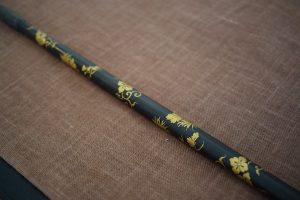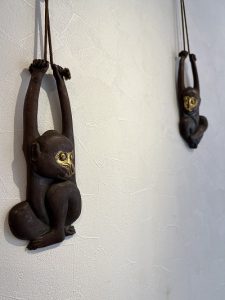みなさまこんにちは、スタッフNでございます。
最近ミニストップに行くと、トリュフ香るチキン&ポテトが美味しくて買ってしまうのですが、なんと、今日は缶コーヒーが当たりました。
こんな日々の小さなラッキーが嬉しくなる今日この頃でございます。
さて、古美術風光舎名古屋店に新しく煙管(キセル)が加わりました。

煙管の使用方法は、刻んだたばこ葉を火皿に詰めて、吸い口から喫煙致します。
日本では紙巻たばこが主流になる前は、もっとも一般的な喫煙方法でございました。
日本や中国、朝鮮半島など東アジア地域で親しまれ、日本では江戸時代からキセルでの喫煙が広がりました。
喫煙が文化的な嗜みとして幅広い身分に広まるとともに、さまざまな形状のキセルが生み出され、蒔絵や彫金などの装飾が施されたものもありました。
先端に火皿がついた「雁首」、たばこの煙を通す「羅宇」、煙を吸う「吸い口」の3つから構成されます。火皿と吸い口を金属などで作り、羅宇に竹や木などを用いた「羅宇キセル」と、すべてを金属で作った「延べキセル」の2種類に分けられます。
江戸時代、キセルは持つ人の個性を映し出すアイテムでした。
キセルを持ち運ぶ「たばこ入れ」にもさまざまなものがあり、人々の”マイキセル”へのこだわりは強かったようです。
現在でも日本の「粋」な文化を象徴するアイテムとして、根強い愛好家がおります。
キセルに詰めるたばこ葉には、「細刻み」という髪の毛ほどの細さに刻まれたものが用いられていました。
その吸い味はマイルドで、軽い味わいが特徴的です。

細刻みたばこは日本特有のもので、細く刻むために、乾燥させた葉の皺を広げるという独自の工程や、切れ味のよい包丁による刻みの技術が生まれました。
たばこが日本に伝来すると、物珍しさも手伝い、世にはたばこをたしなむ人が現れるようになります。
やがて“刻んだ葉たばこをキセルに詰めて吸う”という喫煙方法は一般的となり、広く人々の間に普及していきました。
その当初、粗く刻まれていた葉たばこは、次第に細く刻まれるようになり、江戸時代半ば(18世紀中ごろ)には毛髪ほどの細さになります。この「細刻みたばこ」と呼ばれるたばこは、世界でも類を見ない日本特有の品であり、日本における独自の喫煙文化の発展に大きな影響を及ぼしました。
日本の喫煙文化を語る上で欠かすことのできないキセルは、ヨーロッパのパイプや、東南アジアの喫煙具をまねたものと考えられています。
そのためか、伝来当初のキセルはとても長く、たばこを詰めるための火皿も大きいものでした。しかし「細刻みたばこ」が世に広まると、キセルの火皿は小さくなり、長さも携帯しやすいように短くなっていきます。
また、幕府の政策によって華美な装いを禁じられた江戸時代の人々にとって、帯に差すなどして持ち歩く身近な道具のキセルは、数少ないファッション・アイテムの一つでもありました。これゆえ、実用性を重視しながらも、ファッション性を兼ね備えたキセルが作られるようになったのです。
たばこが伝来した当初のキセルは、持ち手にあたる羅宇の部分が長く、全長が70cmを超えるものまでありました。また、火皿も大きく、キセルの頭部に当たる雁首が湾曲していました。
時代が下るにつれ、人々は外出先でもたばこをたしなむようになります。
その結果、キセルは携帯しやすいサイズとして小型化され、主に20〜30cmの長さのものが好まれました。
アクセサリーの役割も担っていたキセルには、人々の趣向に合わせたさまざまな意匠が施されました。特に、吸い口や雁首には、複雑なデザインが用いられたのです。
幕末から明治にかけて海外の文化が日本へと流入すると、西洋文化の急速な広がりが、当時の日本の喫煙形態にも大きな変化をもたらします。
西洋から伝えられた喫煙方法には「葉巻」や「パイプ」、「紙巻たばこ(=シガレット)」での喫煙がありました。
特に、手軽さやハイカラさも手伝って注目を集めた「紙巻たばこ」は、次第に国内で生産されるようになり、日本の主要産業の一つへと成長します。
また、幕末に日本へ伝えられたマッチも、手軽な着火具として瞬く間に普及。
この結果、喫煙に必要な道具をそろえたたばこ盆が小型化したほか、マッチケースといった新たな道具までが誕生したのです。
西洋の文化が流入し、喫煙形態が変化したとはいえ、明治時代においても主流を占めていたのは、依然としてキセルによる喫煙でした。
江戸時代の大きく奇抜なキセルと比べ、明治時代のキセルは全体的に細く短いものとなっていきます。
さらに、異なる金属を貼り合わせるなど、彫金技術はより複雑になっていきました。
この理由には、キセルに用いる素材や細工に法的な制限がなくなったことをはじめ、廃刀令によって刀装飾の職を失った金工師たちが、喫煙具の製作に携わるようになったことなどが挙げられます。
こうして明治時代には、キセル文化の最盛期ともいえるほど、質の高いキセルが生み出されるようになりました。
キセルの質が持ち主のセンスを表すとうたわれていたこともあり、明治時代には、キセルの形状がさらに洗練されていきます。
奇抜な形や極端に太いキセルなどは少なくなり、キセルを持つ手の美しさを引き立たせるかのごとく、キセルは細く短くなりました。
キセルが日本で独自に発展を遂げた喫煙具であることは確かですが、キセルによる喫煙は日本のみの風習ではなく、中国や朝鮮半島などでも広く行われていました。東アジアの国々で用いられてきたキセルは、雁首と吸い口、羅宇からなる基本構造こそ日本と変わらぬものの、その雰囲気は、日本のキセルと多少異なっています。
明治37(1904)年に施行された「煙草専売法」によって開始されたたばこの専売は、昭和60(1985)年まで続きました。
この間、社会情勢は大きく変化し、たばこを取り巻く環境も変遷を遂げていきました。
まず大正時代に入ると、都市部を中心に「紙巻たばこ」の需要が増え、人々の喫煙形態は“「細刻みたばこ」をキセルに詰めて吸う喫煙”から“「紙巻たばこ」での喫煙”に変化していきます。
そして第2次世界大戦後には、ライフ・スタイルの変化に伴って個人の嗜好が多様化。
さまざまな特徴を持つ「紙巻たばこ」の銘柄が多数作られるようになりました。
一方でキセルによる喫煙は激減し、日本で製造されている「細刻みたばこ」は一つの銘柄を残すのみとなったのです。
「紙巻たばこ」の普及による喫煙形態の変化によって、大正時代以降には、キセルによる喫煙は減少していきます。
そして第2次世界大戦後には、日本人の生活からキセルはほとんど姿を消し、主に伝統文化を継承する歌舞伎などの演出で、限定的に使用されるようになりました。
しかし、日本のキセルは新潟県燕市などの地域で、伝統工芸品の一つとして、昔かたぎな職人たちの手によって作られ続けてきました。
これが近年では、その歴史や細工の美しさも相まって、再び人々の関心を集めつつあるのです。
時代劇や歌舞伎の舞台などでは、江戸時代の風俗を示すシーンにおいて、効果的な演出をする小道具の一つとしてキセルが用いられます。
特に歌舞伎では、キセルの形状で持ち主の人柄を示すだけでなく、男女の愛情を表現する場面で利用されるなど、舞台演出における重要な役割を果たしているそうです。
現代でもアニメのキャラクターが、個性を出すために煙管を加えていたりいたしますね。
Nはたばこは吸わないのですが、煙管を加えて着物で写真を撮ってみたいなあなんて思ってしまいました。
古美術風光舎では煙管などの買取も行っておりますので、ご自宅のお掃除の際には是非よろしくお願い致します。
ではでは

Hello everyone, this is Staff N.
Recently, when I go to Ministop, I buy truffle-scented chicken and potatoes because they are delicious.
It’s around this time that the small lucky days like this make me happy.
Well, a new smoke pipe (kisel) has been added to the Antique Fukousha Nagoya store.
To use the smoke pipe, put chopped tobacco leaves into the grate and smoke from the mouthpiece.
Before cigarettes became mainstream in Japan, it was the most common method of smoking.
It has become popular in Japan, China, the Korean Peninsula, and other East Asian regions.
As smoking spread as a cultural hobby among a wide range of social classes, kiseru came in various shapes, some with decorations such as lacquer and engraving.
It consists of three parts: the gankubi, which has a grate at the tip, the rau, which lets the smoke through, and the sucker, which sucks the smoke. There are two types of kiseru: the rauu kiseru, in which the grate and mouthpiece are made of metal, etc., and bamboo or wood is used for the rau;
In the Edo period, kiseru was an item that reflected the personality of the person who owned it.
There were various kinds of “tobacco pouches” to carry kiseru, and it seems that people were very particular about “my kiseru”.
Even today, it has a strong fan base as an item that symbolizes Japan’s “smart” culture.
Tobacco leaves that were stuffed into kiseru were cut into pieces as thin as a hair, called ‘chopped’.
It has a mild taste and is characterized by a light taste.
Shredded tobacco is unique to Japan, and in order to cut it finely, a unique process of widening the wrinkles of dried leaves and cutting technology with a sharp kitchen knife were born.
When tobacco was introduced to Japan, people began to enjoy tobacco, partly because of its curiosity.
Before long, the smoking method of “packing chopped tobacco into a pipe” became common and spread widely among people.
Initially, tobacco leaves were cut coarsely, but gradually they were cut finer, and by the mid-Edo period (mid-18th century) they were as thin as a human hair. This tobacco, called “shredded tobacco”, is unique to Japan and has a great impact on the development of Japan’s unique smoking culture.
The kiseru, which is indispensable when talking about Japanese smoking culture, is thought to have imitated pipes from Europe and smoking tools from Southeast Asia.
Perhaps for this reason, the original kiseru was very long and had a large grate for the tobacco. However, as “finely chopped tobacco” spread throughout the world, the kiseru’s grate became smaller and shorter to make it easier to carry around.
In addition, for people in the Edo period, who were prohibited from wearing extravagant clothing under the shogunate’s policy, the pipe was one of the few fashion items that was a familiar tool that they carried around by attaching it to their obi. For this reason, kiseru that combines fashion while emphasizing practicality has come to be made.
When tobacco was first introduced, the kiseru had a long rau, which was the handle, and some were over 70 centimeters in length. In addition, the grate was also large, and the goose head that hit the head of the kiseru was curved.
As time went by, people started to smoke even when they were out.
As a result, kiseru was miniaturized for easy portability, and 20 to 30 cm lengths were mainly preferred.
Kiseru, which also served as an accessory, was decorated with various designs to suit people’s tastes. In particular, complex designs were used for the mouthpiece and goose neck.
When foreign cultures flowed into Japan from the end of the Edo period to the Meiji period, the rapid spread of Western culture brought about major changes in smoking patterns in Japan at the time.
Smoking methods introduced from the West included smoking with ‘cigars’, ‘pipes’, and ‘cigarettes’.
Cigarettes in particular, which attracted attention for their ease of use and stylish color, gradually began to be produced domestically and grew to become one of Japan’s major industries.
Matches, which were brought to Japan at the end of the Edo period, quickly became popular as a handy ignition tool.
As a result, tobacco trays containing all the necessary tools for smoking were made smaller, and even new tools such as match cases were born.
Although smoking styles changed with the influx of Western culture, pipe smoking was still the mainstream in the Meiji era.
Compared to the large and eccentric kiseru of the Edo period, the kiseru of the Meiji era became thinner and shorter overall.
In addition, engraving techniques became more complex, such as bonding different metals together.
The reason for this is that there are no legal restrictions on the materials and workmanship used for pipes, and metalworkers who lost their job of decorating swords due to the ban on swords began to engage in the production of smoking tools. is mentioned.
In this way, high-quality kiseru came to be produced in the Meiji era, which could be called the golden age of kiseru culture.
It was said that the quality of the kiseru represented the taste of the owner, and the shape of the kiseru was further refined in the Meiji period.
Strange shapes and extremely thick kiseru have become rare, and the kiseru has become thinner and shorter, as if to emphasize the beauty of the hand holding the kiseru.
It is true that the pipe is a smoking tool that developed independently in Japan, but smoking with a pipe was not only a custom in Japan, but was also widely practiced in China and the Korean Peninsula. Although the basic structure of the kiseru used in East Asian countries is the same as in Japan, consisting of a goose neck, a mouthpiece, and a rau, the atmosphere of the kiseru is somewhat different from that of Japan.
Tobacco monopoly started by the “Tobacco Monopoly Law” enforced in 1904 (Meiji 37) continued until 1985 (Showa 60).
During this period, the social situation changed dramatically, and the environment surrounding tobacco also changed.
First, in the Taisho period, the demand for cigarettes increased, especially in urban areas, and people’s smoking style shifted from “smoking with finely chopped tobacco” to “smoking with cigarettes”. It will change.
After World War II, personal tastes diversified as lifestyles changed.
Many brands of “cigarettes” with various characteristics have been produced.
On the other hand, the number of cigarettes smoked by smoking pipes decreased sharply, leaving only one brand of “shredded tobacco” manufactured in Japan.
Due to the change in smoking style due to the spread of “cigarettes”, the number of pipe smokers decreased after the Taisho period.
After the Second World War, the kiseru almost disappeared from the lives of the Japanese people, and it came to be used on a limited basis, mainly in performances such as Kabuki, which inherited traditional culture.
However, in areas such as Tsubame City, Niigata Prefecture, Japanese pipes have been made as one of the traditional crafts by traditional craftsmen.
In recent years, combined with its history and the beauty of its craftsmanship, it is once again attracting people’s attention.
In period dramas and Kabuki stages, kiseru is used as one of the props that effectively directs scenes showing the manners and customs of the Edo period.
Especially in Kabuki, the shape of the kiseru not only shows the personality of the owner, but also plays an important role in stage production, such as being used to express the affection of a man and a woman.
Even in modern times, anime characters add smoke pipes to their characters to make them stand out.
N doesn’t smoke, but I thought it would be nice to add a smoke pipe and take a picture of her in a kimono.
At Antique Fukousha, we also purchase smoke pipes, so please feel free to contact us when cleaning your home.
See you soon
*********************
ご実家の整理やお片付けなどをされている方のご相談などが多くございます。
朝晩少々お寒くなってまいりましたので、お片付けなどくれぐれもご無理のないようになさってくださいませ。
風光舎では古美術品や骨董品の他にも絵画や宝石、趣味のお品など様々なジャンルのものを買受しております。
お片付けをされていて、こういうものでもいいのかしらと迷われているものでも、どうぞお気軽にご相談下さいませ。
また風光舎は、出張買取も強化しております。ご近所はもちろん、愛知県内、岐阜県、三重県その他の県へも出張いたします。
まずは、お電話お待ちしております。
愛知県名古屋市千種区姫池通
骨董 買取【古美術 風光舎 名古屋店】
TEL052(734)8444
10:00-17:00 OPEN
#骨董古美術買取#出張買取#高価買取#無料査定 #煙管
































